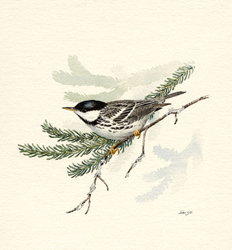Find a Bird - BBA1
Breeding Bird Atlas 1 Species Accounts
Blackpoll Warbler
Dendroica striata
State Status
Special Concern
Egg Dates
mid-June to early July
Number of Broods
one.

The Blackpoll Warbler is a rare and peripheral breeding species in Massachusetts, nesting in recent years only at a high elevation on Mount Greylock in northern Berkshire County. There is a historical breeding record from Savoy. This warbler occurs in the Commonwealth at the southern limit of its breeding range, which extends from the higher elevations of northern New England to the extreme northern edge of the boreal forests from Labrador to Alaska. In recent years, the number of local breeders has been declining, perhaps due in part to increasing human disturbance.
Blackpoll Warblers are common migrants throughout the state in late spring, and they are among the last wood-warblers to pass northward in late May and early June. Only a few early individuals appear before the middle of May. Their large numbers are often difficult to detect as they forage in the tops of the newly leafed-out trees.
The song of the blackpoll is one of the highest pitched songs of any North American passerine. It is an insectlike, high, thin tsit-tsit-tsit-tsit-tsit given on one pitch, becoming slightly louder and more emphatic in the middle and diminishing toward the end. The last notes are sometimes run rapidly together, with almost a sputtering. Another song type is a rapid ti-ti-ti-ti-ti-ti-ti-ti. The call notes are a high-pitched lisp, which resembles zeet, and several emphatic chip notes.
On Mount Greylock, breeding Blackpoll Warblers are found in patches of stunted Balsam Fir, where they glean insects from needles and twigs and sometimes dart out from branches to catch flying insects. Males establish territories during June. Nests are built in branches 1 to 10 feet above the ground and are constructed of small twigs, pieces of bark, dried grass, moss, and lichen and lined with feathers, plant fibers, and fine rootlets. The clutch size is four to five eggs, which are creamy or grayish white and speckled and blotched with varying shades of chestnut, gray, or purple. Observations of the birds indicate that nests with eggs may be found from mid- to late June, occasionally into early July (Hendricks). Females construct the nests and incubate the eggs while males will bring food to their mates, and later to the young. The incubation period is about 11 days, and the young fledge in another 11 to 12 days. A single brood is raised per year.
During late summer, Blackpolls roam the woodlands in association with chickadees and other warbler species. At this time, the adults undergo a complete molt, resulting in the drab greenish autumn plumage, which, for the male, is in stark contrast to the natty spring plumage. The first migrants begin to appear in Massachusetts in early September, and peak numbers are encountered in late September and early October, at which time this warbler can be surprisingly abundant. Blackpolls often spend up to a week or more foraging in a favored staging area where they will build up their fat reserves so as to sustain themselves on their continued journey south. The evidence to date indicates that most blackpolls depart from the Northeast on a nonstop, over-ocean migration south to their wintering grounds in South America, from Colombia and Venezuela south to Brazil and Ecuador. Most blackpolls have departed Massachusetts by late October, but a few individuals are present each year in November.
The Blackpoll Warbler is listed as a species of special concern in Massachusetts.
Map Legend and Data Summary
Atlas 1 data collected from 1975-1979


Note: rare and local in coniferous forest of highest elevations of Berkshire Country, mainly on Mount Greylock
Scott M. Melvin



